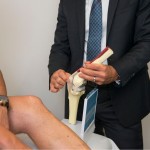
Muscles tears or strains are common sporting injuries. Depending on the injury, symptoms can include muscle tightness, bruising, weakness or inability to fully stretch your injured muscle and in severe cases the inability to walk.
Strains and tears are graded depending on severity as:
Grade 1: a mild muscle strain – likely to recover in a few days
Grade 2: a partial muscle tear
Grade 3: a complete muscle tear – which is most often seen in active athletes and can take a longer period of weeks or even months to heal.
The hamstring and quadriceps are particularly susceptible to injury in sports.
The hamstring group of muscles are located on the back of the upper thigh.
There are three separate muscles that make up the hamstring being the Biceps Femoris, Semimembranosus and Semitendinosus.
Hamstring problems can occur from sports such as football, netball, basketball and tennis which require a high degree of speed, power and agility. Actions involving sudden movement can result in force being applied to the hamstring muscle causing a tear. Sometimes a “pop” can be heard when the muscle is injured.
Risk factors that are known to contribute to hamstring tears include:
- Previous hamstring injury
- Increased age of player
- Sudden change in direction that involves acceleration or deceleration
Other contributing risk factors can include:
- Poor flexibility
- Poor strength
- Muscle fatigue
- Imbalance in muscle strength between the hamstrings and quadriceps
- Lack of warm up or an inappropriate warm up
The quadriceps are a group of muscles located on the front of the thigh.
There are four muscles in this group being the vastus lateralis, vastus medialis, vastus intermedius and the rectus femoris.
Quadricep injuries most commonly occur following sprinting, jumping or kicking activities.
Other factors that can contribute to strain and tear injuries include:
- Running mechanics
- Fatigue
- Playing surfaces
- Lack of warm up or an inappropriate warm up
If you have a Grade 1 or Grade 2 strain your doctor will likely recommend you follow the RICE method of treatment.
- Rest (take a break from sports)
- Ice the injured area to reduce swelling
- Compress the muscle with an elastic bandage
- Elevate the injured leg
A Grade 3 strain or tear is a severe injury. You will feel strong pain and may need crutches to assist you to walk. The area of injury will have immediate noticeable swelling and bruises will usually be showing within a 24 hour period.
With all muscle strains and tears – if pain persists make sure you seek medical attention. You may be sent for a Diagnostic MRI to specifically identify the grade of the tear and its exact location. You may then be referred to consult with an orthopaedic surgeon to correctly diagnose and treat the injury. Occasionally surgery is required for injuries to the tendon of the muscle.
Dr Shidiak is a Sydney based Orthopaedic Surgeon specialising in conditions of the musculoskeletal system and is able to diagnose, treat and rehabilitate muscle tear injuries. Dr Shidiak is the Chief Medical Officer for the Parramatta National Rugby League Club (Parramatta Eels) as well as their feeder club Wentworthville RLC, and has been affiliated with these clubs for 14 and 4 years respectively.
His current role with elite athletes along with his prior role as physiotherapist for the Sydney Olympic team allows Dr Shidiak to provide the most up to date and effective treatment of sporting injuries for athletes. To book an appointment with Dr Shidiak today, contact us on 02 9606 3333.


